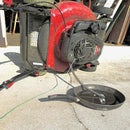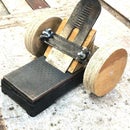Introduction: A Good Use for an Old Phone Charger
Indoor/outdoor thermometers are handy, but the outdoor transmitter can consume too many batteries, depending on the unit. I decided to power the outdoor transmitter with an old phone charger. The voltage of the phone charger needs to be dropped about two volts to match the requirements of the transmitter. This Instructable is really about altering the voltage output of an old 5 volt switch mode phone charger to fit special power needs you might have.
I powered up the transmitter for this thermometer with some partially used AAA batteries. Notice the battery with a diagonal line through it on the upper half of the display. This is a weak battery symbol.
Materials
- Switch mode phone charger with a 5 volt, 0.5 to 1.0 amp. output
- #24 speaker wire
- 1N4001 diodes
- Brass sheet
- Electrical tape
- Solder
- Dowel rod
- Staples for doorbell wire
- Mounting screw
Tools
- Multi-meter
- Soldering iron
- Heat sink
- Side cutter pliers
- Knife or wire stripper
- Wood saw
- Precision Phillips screwdrivers
- Toothpick
- Jumper wires with alligator clips
- Hammer, etc. for mounting wire and transmitter
Step 1: Phone Chargers
The output on these is typically very close to 5 volts at 0.5 amp. to 1 amp. In order to power the outdoor sender unit on my thermometer I will need to drop the voltage to about 3 volts.
Phone chargers are switch mode power supplies. I once tried to reduce the voltage on a switch mode power supply using an LM317 variable voltage regulator chip. It did not work. The power supply shut down until I removed the regulator chip.
Step 2: Dropping the Voltage
In theory it should be possible to drop the voltage appropriately using resistors. But, power dissipation (wattage) becomes a consideration in addition to the number of Ohms needed, and that is a problem. With 1 amp. flowing the correct resistance to drop the voltage by two volts is 2 Ohms, but that resistance needs to be able to handle 2 Watts and most common resistors are rated at 1/4 or 1/8 Watt.
Common diodes, like a 1N4001, are not expensive, can handle 1 amp., and can drop a voltage flowing through them. I have read that each diode is supposed to drop the voltage 0.6 volts, but a test with a multi-meter shows the voltage drop to be about half of that. Six* diodes dropped the voltage from 4.97 volts to 3.13 volts. (Note: I had three multi-meters available and got a different reading on all three. The difference between the highest and the lowest was 0.7 volt for a high reading of 3.79 volts. See the second photo. I compared the thee meters by reading the voltage across the batteries where the current enters the transmitter unit. Under a load situation like this all three meters were very, very close to each other. I decided the circuitry of my "best" meter was interacting somehow with the anomalies of the switch mode power supply. The cheap little Harbor Freight meter gave the best reading in this situation to my surprise. When I removed the batteries and connected the phone charger with added diodes, the transmitter worked as it should.)
See the third photo. My diodes have been rolling around in a plastic storage tray for quite a few years. The band indicating polarity is all but gone. I used the diode test function on the multi-meter to identify the polarity of the diodes. I used white fingernail polish to mark them for my own benefit. The breadboard was a big help for getting this experiment set up right.
*After my improvised power supply had run for a few minutes to power the outdoor sender unit, the low battery symbol appeared again on the base display. I shunted one of the diodes with a jumper wire soldered in place, and the low battery symbol disappeared. The signal from the transmitter was also stronger and the reading from it on the base display was less likely to disappear, especially when it had to travel across the house through more walls and distance to the room where we prefer to have the display.
Step 3: Solder the Diodes in Place
I want to run a low voltage wire from a wall outlet inside my garage through a crack in the door jamb to the outdoor sensor on the shady side of the house. I spliced the wire from the phone charger to a piece of moderately heavy speaker wire. I removed sections of one conductor and inserted the diodes one at a time. There is some wire between the diodes so the wire is more flexible for necessary bends. Notice the spring clip heat sink. Diodes are very sensitive to heat. Always use a heat sink when soldering diodes and other semi-conductors.
After soldering each diode in place I checked the current flow through the last two diodes using the diode test function to be certain I had not made a mistake. I wrapped the wires in plastic electrical tape when I was finished soldering and testing.
Step 4: Dry Run
I wanted to be certain my modified phone charger would power the transmitter unit. I connected jumper wires from the speaker cable to the input terminals inside the transmitter. Pay attention to where the tip of the battery would be and where the blunt end of the battery would be, or you will have the polarity reversed and the transmitter will not work.
With four terminals available, you may wonder which two are the input terminals. Two are simply a jumper that connects the ends of the batteries to each other, and there will be no voltage at those two terminals. See the second photo. Compare the second photo in the step 2.
Step 5: Make Connections to the Battery Bays
I cut a thin strip of paper and fitted it just like the thin brass you see here. Then I used it as a pattern to cut the thin brass. I made dummy forms from 3/8 inch wooden dowel rod. See the second photo. One of the dowel ends needs a point on it similar to the tip of a battery so good contact will be made with the terminal inside its recessed area.
Step 6: The Other Connection
The photo shows another paper strip for sizing the second brass strip. The first brass strip is in place and held securely by the dowel battery dummy form. These thin brass strips will allow me to run conductors to the outside of the transmitter without chewing out part of the case the size of a speaker cable.
I already learned each time I tamper with the power to the transmitter I need to press the reset buttons on the transmitter first, and then on the display unit inside the house. The transmitter reset requires the removal of three small screws easily lost when working on a ladder near where the transmitter will be located. I measured carefully and drilled a hole through the back of the case so I can push the reset with a toothpick, and without removing the three screws. Even though the transmitter will be under the eaves and protected from weather, I will put a piece of electrical tape on the back to seal the hole during normal operation.
Step 7: Test
I connected jumper wires to the brass strips and to the leads for the phone charger with the diodes added. The wider strip is the negative (-) side. The transmitter works. After resetting the transmitter and the display unit, everything worked as it should.
Step 8: Almost Done
As you can see the transmitter is working with power from the modified phone charger and no batteries. The low battery symbol has disappeared.
The outside reading is higher than the inside reading because the transmitter is not yet mounted on the outside of the house. Rather, it is on a dining table under some incandescent lights where I have been working on this project. What remains to be done is to run the speaker cable through the crack in the garage side door and staple it neatly in place. Then I need to mount the transmitter under the eaves of the house and solder the ends of the speaker cable to the brass strips. I will need to press the reset on both units and then all should be good. (If we lose power to our house, I will need to follow the reset process again.)
I have some partially used AA batteries my wife would like gone from our refrigerator. Eventually I will modify another old switch mode phone charger to power the inside unit, as well.
Some phone chargers shut down momentarily. You may want to add a smoothing capacitor with a value of 1000 micro-farads, or so.
Step 9: Other Uses for an Old Phone Charger
I have a CD/MP3 player that I could easily power with another reduced voltage phone charger and two wooden battery dummies. I have a Walkman type AM/FM radio/tape player I sometimes keep on my nightstand in case I am awake and want to listen until I fall asleep again. I even have the right male power jack for the 3 volt input jack. I could power it from a modified phone charger, too. If I needed a 4.5 volt power supply, I could tap into the string of diodes for 3 volts to get close to the right voltage for something with that power requirement. A small resistor could be used to dial in the power supply's output to just the right figure. The amount of power dissipated by a small resistor to bring voltage down from 4.7 volts to 4.5 volts at even 1 amp. is less than 1/4 Watt and would not overheat the resistor.
The photo shows another use for an old phone charger. So many of our current devices can be powered through a USB cord. The output of a switch mode phone charger is exactly what USB devices require. As long as the phone charger is of a good quality and not excessively cheap and "noisy," you can attach the female end of a USB cord and have an extra portable USB charger. Save the male end and attach it to something, like a small iPhone or iPod speaker so it can be used with AC power instead of batteries that cost money, need replacement, and become waste for disposal.











